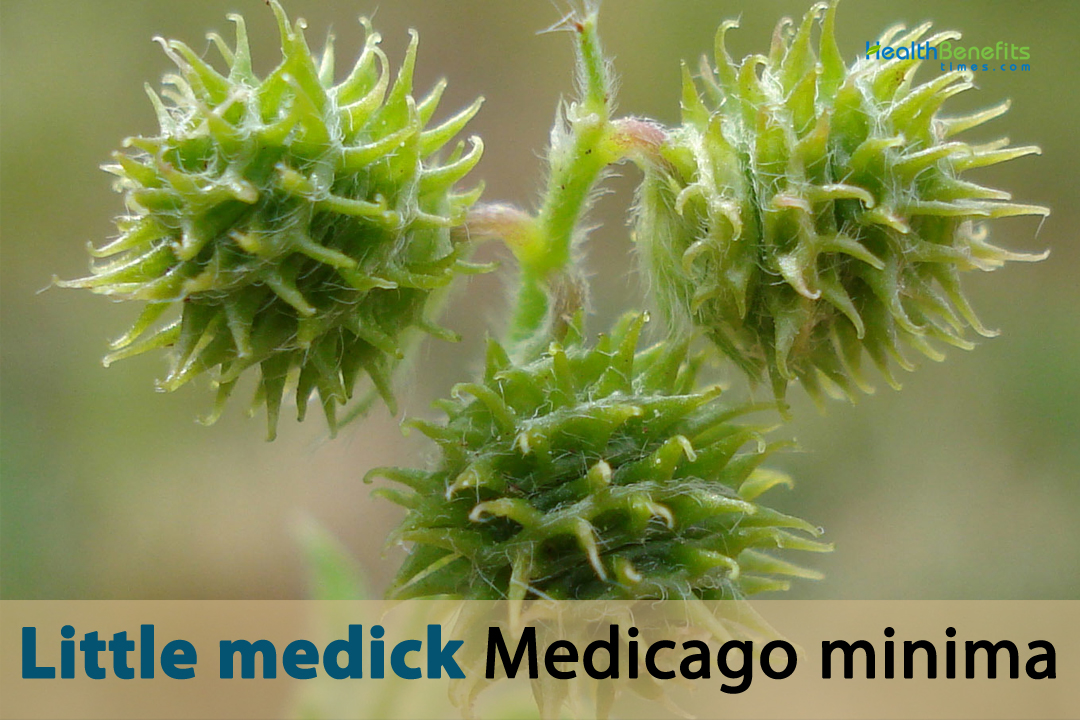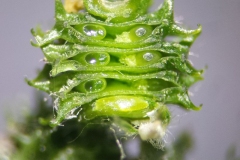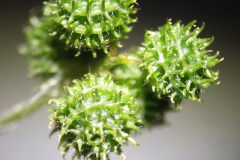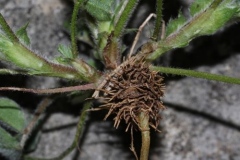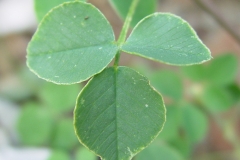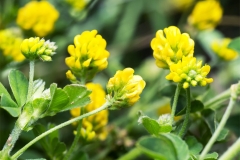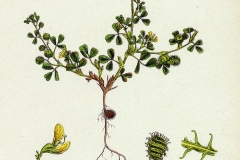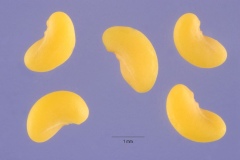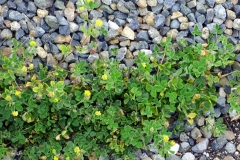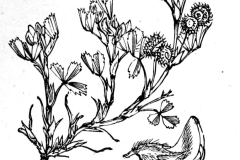| Little medick Quick Facts | |
|---|---|
| Name: | Little medick |
| Scientific Name: | Medicago minima |
| Origin | Native to Europe and Western Asia. Its natural range includes France, Spain, Portugal, Italy, Greece, Turkey, Cyprus, Israel, Jordan and Lebanon |
| Colors | Initially green turning to light to dark brown or tan |
| Shapes | Spirally coiled or contorted legume with hooked bristles or prickles containing one or two seeds |
| Taste | Mild and slightly sweet, nutty, or grassy flavor |
| Major nutrients | • Protein • Fiber • Vitamins • Minerals • Phytonutrients • Carbohydrates |
| Health benefits | Digestive Health, Immune Support, Weight Management, Skin Health, Cardiovascular Health, Blood Sugar Regulation, Bone Health, Respiratory Health, Gut Health, Menopausal Support |
| Name | Little medick |
|---|---|
| Scientific Name | Medicago minima |
| Native | Native to Europe and Western Asia. Its natural range includes France, Spain, Portugal, Italy, Greece, Turkey, Cyprus, Israel, Jordan and Lebanon |
| Common Names | Burr medic, Little burclover, Small burr medic, Lesser medick, Low burr medic, Small hop clover, Black medic, Little trefoil, burry medic, Common little medick, Tiny burr medic, Bur-clover, Lesser burr medic, Small medick, Slender medick, Slender bur-clover, Small yellow trefoil, Slender yellow medick |
| Name in Other Languages | Albanian: Jonxha e vogël, jonxhë Arabic: Atfalat alsaghira (الطفلة الصغيرة), Al-Tib Al-Sagheer (الطب الصغير), qisat qasira (فصة صغيرة) Assamese: Soru Medick (সৰু মেডিক) Bengali: Chhoto Medik (ছোট মেডিক), Little Medik (লিটল মেডিক) Bulgarian: Drebnoplodna lyutserna (дребноплодна люцерна), drebna lyutserna (дребна люцерна) Catalan: Melgó mínim Chinese: Xiǎo mùxù (小苜蓿), Xiǎo Yīyòng Mùxu (小醫用苜蓿), Tiānlán mùxu (天蓝苜蓿) Croatian: Sićušna vija Czech: Malý Luzerne, Malý jetel, tolice nejmenší Danish: Lille Lucerne, Lille Medicago, Liden sneglebælg Dutch: Kleine Medicago, Kleine rupsklaver English: Little Medick, Little bur-clover, Bur medick, Goldfields medic, Little medic, Small medic, Woolly trefoil Estonian: Väike lutsern Finnish: Pieni Apila, Pikkumailanen French: Petite luzerne, Luzerne naine Georgian: P’at’ara ionja (პატარა იონჯა) German: Kleiner Klee, Zwerg-Schneckenklee, Zwergschneckenklee, kleiner Schneckenklee, Zwergluzerne Greek: Mikrí Trifýlli (Μικρή Τριφύλλι), Mikró Loúzern (Μικρό Λούζερν), Mikrí fragká (Μικρή φραγκά) Gujarati: Nanu Methi (નાનું મેથી) Hebrew: Luzeran Katan (לוזרן קטן), aspeset ketannah Hindi: Chhota Medik (छोटा मेडिक), Chhoti Medik (छोटी मेडिक), Chhota Methi Hungarian: Kis Lucerna, apró lucerna Indonesian: Medick Kecil Italian: Medica minore , Erba medica minima Japanese: Ritoru medikku (リトルメディック), Ko umagoyashi (コウマゴヤシ), Medikago minima (メディカゴ・ミニマ) Kannada: Litil Medik (ಲಿಟಿಲ್ ಮೆಡಿಕ್), Sana Menthe (ಸಣ ಮೆಂತೆ) Kazakh: Qırımoşağan (Қырымошаған) Korean: Jageun Medik (작은 메딕), Meok i gae ja ri, jom gae ja ri (좀개자리), teol kkot ja ri pul (털꽃자리풀) Malay: Medick Kecil Malayalam: Little Medik (ലിറ്റിൽ മെഡിക്), Chinna Ventayam (ചിന്ന വെന്തയം) Marathi: Lahan Methi (लहान मेथी) Norwegian: Liten Lusern, Liten søtvepse, Småsnigleskolm Odia: Chhota Methi (ଛୋଟ ମେଥୀ) Persian: یونجه صغیر Polish: Mała Lucerna, Medycyka drobna, Lucerna kolczastostrąkowa Portuguese: Trevo-anão , Småsnigleskolm, luzerna-pequena Punjabi: Chhote Methi (ਛੋਟੇ ਮੇਥੀ) Romanian: Lucernă Mică, Mic lucernă Russian: Medik malyy (Медик малый), Malen’kaya lyutserna (Маленькая люцерна), Malen’kaya lyutserna (Маленькая люцерна), Liutserna khmelevaia, Liutserna malen’kaia, lyutserna malaya (люцерна малая), lyutserna malen’kaya (люцерна маленькая) Serbian: Mala vija (мала вија), majušna dunjica (мајушна дуњица) Slovak: Lucerna najmenšia, tolica najmenšia Slovenian: Drobna meteljka Spanish: Trébol enano , Carretilla menor, Carretón chico, Carretones, Melgó mínim, Mielga, Userda borda, carretilla, medicago minimo Swahili: Medick Ndogo Swedish: Liten snärjmara , Liten Lusern, Liten sötväppling, Sandlusern, Sandlucern, Sandluzern, Tamil: Siriya Medik (சிறிய மெடிக்), Siriyavendayam (சிறிய வெந்தயம்) Telugu: Litil Medik (లిటిల్ మెడిక్), Chinna Mentulu (చిన్న మెంతులు) Thai: Mīdik Lęk (มีดิกเล็ก) Turkish: Küçük Yonca, Küçük Ebegümeci, gurnik Ukrainian: Malyy Lyutsern (Малий Люцерн), lyutserna malenʹka (люцерна маленька) Upper Sorbian: Drobna šlinčina Urdu: Chhota Medick (چھوٹا میڈک) Vietnamese: Cỏ Rừng Nhỏ, Linh lăng nhỏ Welsh: Maglys Bach |
| Plant Growth Habit | Small, sprawling annual herb with a prostrate or ascending growth habit |
| Growing Climates | Low roadsides, disturbed shores, waste lots, sandy slopes, waste fields, stream banks, fields, meadows, disturbed areas, and other moist open habitats. It is usually found in non-wetlands, but occasionally in wetland areas |
| Soil | It can grow in different kinds of soil, but it does best in well-drained soil with a pH between 6.0 and 7.5. Good fertility in the soil is best |
| Plant Size | 10-30 cm (4-12 inches) |
| Root | Taproot system that is typically thicker and longer than the lateral roots |
| Stem | Stems are solid, sparsely to densely hairy and less than 1 m tall |
| Leaf | Leaves are alternate and petiolate, stipules conspicuous. The stipules are green, triangulate to lanceolate or foliaceous. Leaves are hairy on one or both sides |
| Flowering season | Start as early as March or April and may extend into June or July |
| Flower | Flowers are orange or yellow, zygomorphic. Petals are separate and clawed, calyx hairy. There are 9- 10 stamens with 9 united, 1 free (diadelphous) |
| Fruit Shape & Size | Fruit is spirally coiled or contorted legume with hooked bristles or prickles containing one or two seeds |
| Fruit Color | Initially green turning to light to dark brown or tan |
| Seed | Seeds are olive, brown, or black with a smooth surface |
| Flavor/Aroma | Mild and grassy aroma |
| Taste | Mild and slightly sweet, nutty, or grassy flavor |
| Varieties |
|
| Plant Parts Used | Leaves, seeds and roots |
| Propagation | By seed, division, cuttings, layering |
| Lifespan | Approximately one year |
| Season | May, June till July |
| Major Nutrition |
|
| Available Forms |
|
| Health benefits |
|
Plant Description
Little medick is a small annual herb that spreads out and grows in a prostrate or rising way. It usually grows between 10 and 30 cm (4 to 12 inches) tall. The plant grows along low roadsides, disturbed shores, waste lots, sandy slopes, waste fields, stream banks, fields, grasslands, disturbed areas, and other moist, open places. It usually lives in places that aren’t wetland, but sometimes it can be found in marsh areas. It can grow in different kinds of soil, but it does best in well-drained soil with a pH between 6.0 and 7.5. Good fertility in the soil is best, but little medick is known for its ability to take nitrogen from the air, which can help the soil get better over time.
In the past, some Medicago species, like M. minima, have been used in traditional medicine because they might have healing qualities, like helping with digestive problems. But there isn’t much evidence that these plants are used as medicine or that many people do so. In some places, Medicago minima are used as feed for animals because it tastes good to them and gives them energy. It can be thought of as an invasive species because it can adapt to many different kinds of environments and outcompete local plants.
Appropriate growing environment for little medick
Little medick also known as small medick is a low-growing annual plant that belongs to the pea family (Fabaceae). It is often used as a forage crop, a cover crop, or as part of a wildlife habitat. To successfully grow little medick, you should consider the following appropriate growing conditions:
- Climate: Little medick can grow in many different temperatures, but it does best in the Mediterranean climate. This includes places where winters are mild and wet and summers are hot and dry. But it can also grow in regions that are between temperate and tropical.
- Sunlight: Little medick would rather be in the sun than in the shade. It will grow best if it gets direct sunshine for at least 6–8 hours a day.
- Soil: It can grow in different kinds of soil, but it does best in well-drained soil with a pH between 6.0 and 7.5. Good fertility in the soil is best, but little medick is known for its ability to take nitrogen from the air, which can help the soil get better over time.
- Moisture: Little medick can survive a little bit of dryness once it is established, but it still needs regular watering, especially when it is germinating and getting started. Make sure the dirt is always moist, but not soggy.
- Seeding: When the earth is ready, sow small medick seeds right into it in early spring or late summer. A popular way to plant seeds is to spread them out evenly over the planting area and lightly rake them into the soil.
- Spacing: Spread the seeds or plants out about 6 to 12 inches to let them grow and get enough air.
- Competition: Even though little medick can fight with weeds to some degree, it’s best to keep the planting area as free of weeds as possible, especially during the “establishment” phase.
- Fertilization: Since little medick is a nitrogen-fixing legume, you might not need to add extra fertilizer if the soil is good. But if the earth doesn’t have enough nutrients, you can use a balanced, low-nitrogen fertilizer in small amounts.
- Maintenance: Little medick isn’t too hard to take care of. Keep an eye out for pests and diseases, and if it gets too tall or starts to hurt other plants, you might want to mow it or cut it back.
- Harvest: If you grow little medick as a forage crop, you can cut it when it’s in full growth to make hay or silage. Let it grow until it is 8–12 inches tall before you cut it.
- Rotation: If you want to improve the health and fertility of your land, you might want to mix little medick with other crops in your planting plan.
Roots
Little Medick has a taproot system, like many other plants. This means that it has one main root in the middle, from which smaller roots grow out in all directions. Most of the time, the taproot is larger and longer than the side roots. The immature root of the seed grows into the main root of Little Medick, which is also called the primary root. It is the first root to grow from a seed, and it keeps growing as the plant gets bigger.
Stem
Little Medick is a herbaceous plant, which means that its roots are soft, green, and not woody. Herbaceous plants don’t have woody stems like trees and bushes do. Instead, their stems are bendy and die back at the end of the growing season. Little Medick usually grows low to the ground and has a prostrate or spreading growing habit. It has stems that often branch out, giving it a thick, mat-like look. The stems can be anywhere from a few inches to about a foot long, based on the weather and other conditions. The stems of little medick are covered with small, fine hairs that make them feel a little soft or velvety. These hairs can help the plant lose less water through transpiration and keep predators away.
Leaves
The leaves of Little Medick are arranged alternately along the stem. This means that the leaves are connected at different points along the stem and move from one side to the other as they go up the stem. Each leaf is a complex leaf, which means it has more than one leaflet. Usually, each leaf has three leaflets, giving it a shape called “compound trifoliate.” Most of the time, the leaves are oval or elliptical and have rounded ends. In general, they are small, with lengths of about 0.5 to 1.5 centimetres (0.2 to 0.6 inches). The sides of leaflets are smooth and whole, which means they don’t have serrations or teeth.
Leaflets have fine, soft hairs all over them, which makes them feel a little fuzzy or pubescent. These hairs can help the plant lose less water through perspiration and may protect it from animals. Most Little Medick leaves have pinnate venation, which means that the veins run parallel to each other along the leaf’s length. The veins spread out from a midrib in the middle. A stalk called a petiole holds each leaflet together. The leaflet is connected to the stem by the petiole. In the case of Little Medick, the petioles of the three leaflets on a compound leaf come from a single point. This makes them palmately compound. Most leaflets are bright green, which shows that they have enough chlorophyll for photosynthesis. Stipules are small structures that look like leaves and are at the base of the petioles, where they join the stem. Some stipules change into small, pointed structures called spines or become very small scales. Different plants can have different numbers of stipules and different kinds of stipules.
Flower
The flowers of Little Medick grow in groups called racemes. These racemes are long and have a center stalk with several flowers on it. The flowers have bilateral symmetry, which means that they can be split into two halves that are the same in every way along a single line. This is something that many leguminous plants have in common. Flowers are usually less than one centimeter (0.4 inches) in diameter. Each flower has five petals that are grouped in the shape of a butterfly or a pea. The top petal is called the “standard” or “banner.” The two side petals are called the “wings,” and the two bottom petals are joined together to make the “keel.”
In most cases, the petals of flowers are bright yellow, but in some cases, they may be more orange or cream-colored. The green structure that looks like a leaf and wraps around the flower bud before it opens is called the calyx. The calyx is made up of five sepals that cover the flower as it grows. The ten stamens on a flower are the male reproductive parts. Most of the time, these stamens join together to form a tube around the pistil. The pistil is the female part of the flower that makes seeds. It has three parts: the ovary, the style, and the stigma. The ovary is at the bottom of the flower and holds the ovules, which could become seeds. The style is a thin tube that connects the ovary to the stigma, which is where pollen sticks. Flowers, like bees and butterflies, draw pollinators like bees and butterflies with nectar. Most of the time, the nectar is at the bottom of the flower, where these insects can reach it. Little Medick is pollinated by different insects, especially bees. These insects visit the flowers to get nectar and, by accident, move pollen from one flower to another. This makes it easier for the flowers to get fertilized.
Fruits
The fruit is a legume, which is a type of dry, splitting fruit that is typical of the legume family (Fabaceae). Pods are another name for legumes. Most legumes are small and long, often looking like tiny, skinny spheres. They can be between 0.4 and 0.8 inches (about 1 to 2 centimetres) long or a little longer. When they are fully grown, most beans are light to dark brown or tan. Legumes are dehiscent, which means that when they get old and dry out, they naturally split open along lines or joints. This makes it possible for the seeds to fall out and spread.
Seeds
Most of the time, the seeds of little medick are small, oval, or kidney-shaped. The size can change, but they are usually very small, with a length of less than 2 mm (0.08 in). Seeds can be different colors, but most of the time they are shades of brown, from light tan to dark brown or even black. Each seed has a seed coat, which is a shell of protection around it. The seed coat helps keep the embryo and endosperm inside the seed safe from damage from the surroundings and from being hurt physically. Depending on the type of plant and the climate, the seed coat can be smooth or have a little texture. The hilum is a small scar on the seed coat that shows where the seed was connected to the fruit or pod. It gives the seed a place to hold on to as it grows.
Varieties of Little medick plant
Medicago minima, commonly known as Little Medick or Small Medick, are a species of plant within the Medicago genus. While it may not have as many cultivated varieties as some other plants, there can still be regional variations and adaptations. Here are a few related species and subspecies that are sometimes referred to as varieties:
- Medicago minima subsp. minima: This is the usual type that lives in different parts of Europe and Asia. It is a low-growing plant with tiny yellow flowers that is often used to feed animals.
- Medicago minima subsp. maritima: This type is used to living near the coast, which is why it is sometimes called the “Coastal Little Medick.” It has changed in ways that let it grow in areas with more salt near the coast.
- Medicago minima subsp. neglecta: Some people think of this as a subspecies of the Little Medick. Compared to the usual form, it grows in a more flattened way.
- Medicago minima subsp. intertexta: This subspecies is found in some parts of the Mediterranean area. It may grow differently and have different flowers than the typical form.
- Medicago minima var. truncatula: This is another type of plant that is linked to Barrel Medick. It is similar to Little Medick and is often thought of as a type of Little Medick. It tends to grow straighter up.
- Medicago minima subsp. caput-medusae: This subspecies can be found in Spain, France, and other parts of Europe. It has small, round leaves and grows in a prostrate position.
- Medicago minima subsp. dalmatica: The Balkan Peninsula and parts of southeastern Europe are home to this type. The shape of its leaves and the color of its flowers may be different from the usual form.
- Medicago minima subsp. michalkovae: Some parts of Slovakia and Hungary are where this subspecies is from. It can have flowers of different colors and sizes.
- Medicago minima subsp. tenuifolia: This subspecies lives in Greece and Turkey and other parts of the Mediterranean. It can grow in different ways and have different-sized leaves.
- Medicago minima subsp. sativa: This type is found in different parts of Europe and Asia. It is sometimes called “Sickle Medick.” It has changed so that it can be grown as a food plant.
- Medicago minima subsp. pontica: This subspecies is native to the area around the Black Sea. It may be different from other forms in some ways.
- Medicago minima subsp. pygmaea: This is a small subspecies that lives in the UK and other parts of Europe. It is known for being small and growing in a tight shape.
Health benefits of little medick
Little Medick, scientifically known as Medicago minima, is a lesser-known herb with several potential health benefits. Here’s a more detailed look at these benefits:
1. Digestive Health
Little Medick has been used for a long time to help with digestion. It has chemicals in it like saponins and flavonoids that may help digestion by making stomach enzymes work better. This can help ease stomach problems like pain, bloating, and gas.
2. Anti-Inflammatory Properties
Some studies show that the bioactive chemicals in Little Medick may have anti-inflammatory effects. Chronic inflammation has been linked to a number of health problems, like heart disease, arthritis, and cancer. Little Medick may help avoid or take care of these conditions by reducing inflammation.
3. Antioxidant Effects
Antioxidants like flavonoids and polyphenols are in Little Medick. These help get rid of dangerous free radicals in the body. These antioxidants protect cells from reactive stress and may help the health and well-being of the body as a whole.
4. Diuretic Action
Little Medick is a diuretic, which means it makes you pee more. This can help when there is too much fluid in the body and it needs to be drained, like in light cases of high blood pressure or edema.
5. Immune Support
This plant has vitamins and minerals like vitamin C, vitamin A, and zinc, which are important for a healthy immune system. Adding Little Medick to your food may help your immune system work well and protect you from getting sick.
6. Weight Management
Little Medick is low in calories and fat, so it can be part of a healthy diet for people who are trying to lose weight or keep it off. Also, its ability to help intestines can help people who are trying to lose weight.
7. Skin Health
Little Medick is used to treat skin problems in some old-fashioned ways. When put on the skin or used in skin care products, it may have a soothing and anti-inflammatory effect, which could help with acne or other small skin problems.
8. Cardiovascular Health
Little Medick might be good for the health of your heart. Its fibre content can help lower cholesterol by binding to excess cholesterol in the digestive system and making it easier to get rid of. By making it harder for the body to absorb cholesterol, it may help lower the chance of heart attacks and strokes.
9. Blood Sugar Regulation
Some study shows that Little Medick may help control how much sugar is in the blood. Some of the chemicals in Little Medick, like fibre and certain phytonutrients, may slow down the rate at which sugars are absorbed in the digestive system. This could help control blood sugar levels. This can be especially helpful for people who already have diabetes or are at risk of getting it.
10. Bone Health
Minerals like calcium, magnesium, and phosphorus, which are found in Little Medick, are important for keeping bones strong and healthy. These chemicals help keep bones strong and may help keep diseases like osteoporosis from happening.
11. Respiratory Health
Little Medick has been used for a long time to treat lung problems like coughs and asthma. It might help relieve respiratory pain and help keep the lungs healthy if it has anti-inflammatory and soothing qualities.
12. Nutrient Density
Little Medick is a good source of vitamins (A, C, and K) and minerals (iron and potassium), which are all important for health. Adding it to your diet can help you get a wide range of nutrients that are important for your health as a whole.
13. Gut Health
The fibre in Little Medick can help keep your gut healthy. Fibre feeds the good bacteria in the gut by acting as a prebiotic. A healthy gut micro biome is linked to better digestion, a stronger immune system, and a better sense of well-being all around.
14. Detoxification
Some parts of Little Medick may help the body’s natural ways of getting rid of toxins. For example, it may help the liver break down toxins and get rid of them from the body.
15. Anti-Aging Properties
Antioxidants in Little Medick can help protect skin cells from damage caused by free radicals, which can lead to skin that ages faster than it should. Including it in your diet might help you look younger.
16. Menopausal Support
Little Medick has phytoestrogens in it, which are plant chemicals that can act like estrogen in the body. Some women may find that this helps with menopause symptoms like hot flashes and mood swings.
Culinary Uses of Little medick
Little Medick may not be as commonly used in culinary applications as some other herbs and greens, but it can still be incorporated into various dishes. Here are some culinary uses and ideas for using Little Medick:
- Salads: Little Medick leaves give salads a fresh, slightly spicy taste when they are added. They can be mixed with lettuce, spinach, or arugula to make a salad more interesting and healthy.
- Garnish: Use Little Medick leaves as a garnish to give your foods a splash of color and flavor. You can sprinkle them on soups, pasta, or grilled foods to make them look nice.
- Smoothies: Add some leaves to your green drinks to make them even healthier. They can add to the sweetness of foods and make them taste different.
- Pesto: Use Little Medick instead of regular basil or mix it with it to make a unique pesto. Mix it with garlic, nuts (like pine nuts or almonds), olive oil, and Parmesan cheese to make a tasty sauce for pasta or sandwiches.
- Sandwiches: Adding leaves to sandwiches and wraps makes them taste spicy and herbaceous. They go well with chicken, turkey, cheese, or roasted veggies as fillings.
- Herb Butter: Add freshly chopped leaves and herbs like parsley, chives, or basil to softened butter. This herb butter can be added to grilled or baked foods as a flavoring.
- Soups and Stews: Leaves can be added to soups, stews, and sauces right before they are served to give them a fresh, lively taste.
- Omelets and Scrambled Eggs: You can add a mild, herb-like flavor to omelets or cooked eggs by sprinkling chopped leaves on top.
- Stir-Fries: Stir-fries get a burst of color and freshness from leaves added in the last few minutes of cooking.
- Grain Bowls: You can add Little Medick leaves to grain bowls, like quinoa or rice bowls, to make them look and taste better.
- Pizza Topping: You can put Little Medick leaves on a pizza. You can add them right before serving to keep them fresh and full of flavor.
- Herb Blends: You can make custom herb blends for different meals by mixing Little Medick leaves with other herbs like basil, mint, or cilantro.
- Herb-Infused Vinegar: Add Little Medick leaves to a bottle of white wine vinegar or apple cider vinegar to make vinegar that tastes like a vegetable. Let it sit for a few weeks to give salad sauces and marinades a hint of herb flavor.
- Herb Butter for Seafood: Mix finely chopped Little Medick leaves, lemon juice, and a pinch of salt into softened butter. You can baste and flavor grilled shrimp, scallops, or fish with this herb butter.
- Green Smoothie Bowls: Use Little Medick leaves not only to make green smoothies, but also as a healthy, colorful topping for smoothie bowls. They add a refreshing difference to smoothie bases that are mostly creamy.
- Stuffed Vegetables: Add Little Medick to stuffing mixtures for veggies like bell peppers, zucchini, or mushrooms. Its spicy taste can go well with the stuffing’s taste.
- Herb-Infused Oils: By soaking Little Medick leaves in olive oil, you can make oils that taste like herbs. Use these flavored oils in salad dressings, drizzled over roasted veggies, or as a dip for crusty bread.
- Flavored Cream Cheese: Mix finely chopped Little Medick leaves, crushed garlic, and a pinch of salt into cream cheese. Spread this cream cheese with herbs on crackers, rolls, or sandwiches.
- Sushi Rolls: Adding Little Medick leaves to sushi rolls gives them a unique twist. They can give the rice and seafood a spicy difference.
- Green Wraps: Instead of rolls or wraps, you can use Little Medick leaves. Fill them with your favorite fillings, like grilled chicken, tofu, or roasted vegetables, for a low-carb and gluten-free choice.
- Infused Water: A subtle plant infusion can be made by adding a few sprigs of Little Medick leaves to a pitcher of water. This can be a drink that is both refreshing and hydrating.
- Grilled Skewers: Before grilling, you can put marinated veggies, meat, or tofu on skewers with Little Medick leaves. They will give the skewers a light, green flavor.
- Herb-Crusted Proteins: Mix finely chopped Little Medick leaves with breadcrumbs, Parmesan cheese, and any herbs you like to make a tasty crust for chicken, fish, or pork that will be baked or grilled.
- Herb Rice: Mix together cooked rice, chopped Little Medick leaves, the zest of a lemon, and a little olive oil. This rice with herbs goes well with a lot of different main dishes.
- Homemade Herbal Tea: You can make plant tea from dried Little Medick leaves. Tea can be made by letting the leaves sit in hot water for a while.
Different uses of little medick
Little Medick has various uses beyond culinary and potential health benefits. Here are different uses for Little Medick:
- Livestock Forage: Little Medick is often grown as a feed crop for livestock, especially grazing animals like cattle, sheep, and goats. It gives these animals something to eat that is good for them.
- Green Manure: Little Medick can be used as a green waste crop, just like other legumes. When it is grown and then tilled into the ground, it adds nitrogen and organic matter to the soil, making it better for growing other crops.
- Cover Crop: During times when the land is not being farmed, farmers use Little Medick as a cover crop to protect and improve the soil. Its growth helps stop dirt from washing away and weeds from taking over.
- Soil Stabilization: Little Medick can be used to stop soil loss on slopes and in other places where soil is easily washed away because of its deep roots.
- Wildlife Habitat: Little Medick and other plants like it give birds, insects, and small mammals, among other animals, a place to live and food.
- Honey Production: Little Medick has flowers that bees like, and the juice from those flowers can be used to make honey. Beekeepers sometimes plant it to help bees and increase the amount of honey they make.
- Ornamental Planting: Little Medick is used in ornamental gardens by some gardeners and designers because it has small, yellow flowers and grows slowly. It can be a pretty way to cover the ground or make a fence.
- Traditional Medicine: As was already said, Little Medick has been used in traditional herbal medicine in some countries because it might be good for your health.
- Seed Production: Little Medick is grown for its seeds, which can be used to replant the plant and make more of it for crops or forage.
- Erosion Control: Little Medick has deep roots that help hold the soil together. This makes it useful in projects to stop erosion, such as along riverbanks or on building sites.
- Companion Planting: Some farmers use Little Medick as a companion plant to improve the soil and bring in good bugs like ladybugs and pollinators.
- Green Roof Applications: Little Medick can be used as part of a green roof installation in a city to cover the roof with plants and help handle storm water.
- Educational Purposes: Little Medick is sometimes used in schools to teach students about how plants grow farming, and taking care of the earth.
- Soil Improvement in Restoration Projects: Little Medick can be useful in projects to improve the environment, especially in places where the soil has been damaged by people or by natural processes. Its ability to fix nitrogen can help bring back soil fertility and help local plant species grow again.
- Green Ground Cover: Little Medick is sometimes used in gardening as a green ground cover, especially in places where the soil is poor or hard. It grows slowly and can form a thick mat, which makes it a good choice for covering the ground.
- Seed Bank for Conservation: Some seed banks and conservation projects have Little Medick in them. Keeping the seeds of this plant helps keep its genetic variety and makes sure that it will be around for future efforts to restore the environment.
- Wildflower Meadows: The tiny yellow flowers of Little Medick can add to the beauty and variety of wildflower fields. It brings in pollinators like bees and butterflies, which makes it a great plant for meadows.
- Green Mulch: Little Medick can be used in gardens and farm areas as green mulch. It can help stop weeds from growing between rows of crops, keep the soil wet, and make the soil healthier.
- Educational Research: Researchers and teachers often use Little Medick as a model plant in studies about plant biology, genetics, and how plants interact with their environments because it is easy to grow and has simple needs.
- Traditional Crafts: Some cultures have used dried Little Medick twigs and seed pods to make things like baskets and flower arrangements.
- Livestock Fodder Production: Little Medick can be used for grazing, but it can also be cut and dried to make hay or feed for animals when there isn’t enough food to go around.
- Bio-fertilizer: Little Medick can be added to bio-fertilizers or microbe inoculants, which can improve the health of the soil and make it easier for plants to get the nutrients they need.
- Seed Testing: In farming and horticultural research, the seeds of Little Medick are sometimes used to test seeds and study how they grow.
Side effects of Little Medick
Little Medick is generally considered safe when consumed in moderate amounts, and it is not associated with severe side effects for most people. However, as with any plant or herb, there are some considerations to keep in mind:
- Allergic Reactions: Some people may be allergic to Little Medick or other plants in the family of legumes. Some of the symptoms of an allergic response are rashes, itching, hives, and, in rare cases, more serious symptoms like trouble breathing or anaphylaxis. If you know you are allergic to beans, be careful when you handle or eat Little Medick.
- Digestive Discomfort: Like other beans, Little Medick has chemicals in it that can give some people gas and make them feel full. If you don’t normally eat beans, start with small amounts to see how your body handles them.
- Anticoagulant Properties: Some of the ingredients in Little Medick may have a slight blood-thinning affect. Most people don’t have to worry about this, but people who take blood-thinning medicines or have bleeding problems should be careful about eating a lot of Little Medick.
- Oxalates: Oxalates are found in many leafy veggies, like Little Medick. In people who are prone to getting kidney stones, eating too many oxalates can cause them to form. If you tend to get kidney stones or have had kidney problems in the past, you might want to limit how much Little Medick you drink.
- Medicinal Uses: If you want to use Little Medick for medical reasons, you should talk to a doctor or an herbalist to figure out the right dose and make sure it won’t interact with any other medicines you may be taking.
- Pesticide Residues: Little Medick could be subject to pesticides or other environmental pollutants, just like any other wild or grown plant. Whether you get it from the wild or grow it yourself, make sure it doesn’t have anything that could hurt you.
- Pregnancy and Lactation: Women who are pregnant or nursing should be careful about adding new foods or herbs to their diets, including Little Medick, and should talk to a doctor first.
References:
https://www.itis.gov/servlet/SingleRpt/SingleRpt?search_topic=TSN&search_value=503722#null
https://npgsweb.ars-grin.gov/gringlobal/taxon/taxonomydetail?id=23621
https://www.cabidigitallibrary.org/doi/10.1079/cabicompendium.33035
https://gd.eppo.int/taxon/MEDMI
http://www.theplantlist.org/tpl1.1/record/ild-31590
https://en.wikipedia.org/wiki/Medicago_minima
https://www.flowersofindia.net/catalog/slides/Little%20Bur%20Clover.html
https://plants.usda.gov/home/plantProfile?symbol=MEMI
https://texasinvasives.org/plant_database/detail.php?symbol=MEMI
https://burkeherbarium.org/imagecollection/taxon.php?Taxon=Medicago%20minima
https://www.wikidata.org/wiki/Q144139


